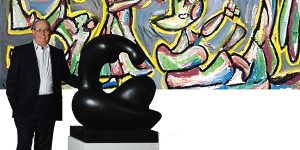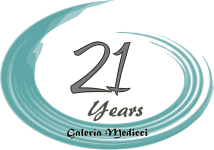Karim Borjas was born in Caracas in 1959 and began his training as a painter at the School of Fine Arts Cristóbal Rojas. In 1983 he moved to Paris, where he still lives today. He began showing his work in 1985 in France and has a long exhibition record, including participations at the Bienale di Livorno in 1994, the Bienal de Fotografía de Puerto Rico, 2012, and the Biennale de Tashkent in Uzbekistan, in 2013. He has had multiple solo shows in galleries and museums worldwide including the Bianca Landgraaf Galerie in the Netherlands, 2008, and the Vilnius Dailés Akademija in Lithuania, 2014.
He has also participated in group exhibitions at the Museo de Arte Contemporáneo de Panamá, the Museo de Arte Moderno in the Dominican Republic, the Museo de las Américas in Puerto Rico, the Museo de Arte de Lima, Peru, the Museum of Fine Arts in Taipei, Taiwan, the Seoul Metropolitan Museum of Arts, the Museum of Latin American Arts, in California and the Centro de Arte Contemporáneo Matadero de Madrid in Spain, to name just a few.
His work is represented in many private an public collections and has received important honors and distinctions, such as the Grand Prix International de la Peinture de la Côte d’Azur in Cannes in 1988 and 1989; the best foreign exhibition in Puerto Rico in 1999 and the Charles Oulmont Prize awarded by the Fondation de France in 2000.
Borjas’s most recent work with photography permits him to encounter today’s world at its most banal and create images that transcend reality, while constantly making reference to the familiar and recognizable. In one of his most dramatic series, “Los Olvidados” (The Forgotten), his goal is to create a new history from the past by piecing together an accumulation of photos and photo fragments in compositions that are often constructed as history paintings, with figures in landscapes that succumb to the detritus of his collections. The array of objects, whole and in pieces, equate familiarity with meaninglessness and diversity, and may serve as a metaphor for the human condition, torn between the comfort of modernity and the challenge to survive amidst garbage and chaos. This constant interest in humanity, relationships, and interaction is also present throughout his career, demonstrated in a variety of media, including installations that focus on gesture and signs and their universal significance.
Such installations afford the artist a new opportunity to investigate all the complexities of humanity, psychologically and physically, while he delves into their meaning through a diversity of techniques. However, words and signs are ever-present. Signs become substitutes for reality that may be considered like threads that weave their way through his work over the years, emerge from the thick and the painterly as mere words, letters or gestures, inform the darkness and bring light out of the shadows, and keep constant the artist’s astute sense of awareness and aesthetic sensibility.
Carol Damian
The Patricia & Phillip Frost Art Museum
Director and Chief Curator

Interview with Mr. Tomás Kepets, director of the Medicci Gallery
Read more
"During those two decades, Galeria Medicci advanced into a river of creations and continues to show the majors artists, the vanguard of every moment, lucidity and everything that bridges with spiritual values. The experiences accumulated in more than two decades have sharpened the dynamics of today ". José Pulido
Works of renowned artists in the United States, the Caribbean and Latin America such as Manuel Mendive, Carlos Luna and the American sculptor Manuel Carbonell, as well as Venezuelan expats based in Paris, France, Annette Turrillo and Karim Borjas.